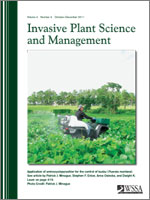Controlled burns and grazing are being tested to manage invasive grasses in the Prairie Pothole region of the Northern Great Plains. These practices, however, may inadvertently promote saltcedar infestations from seed by opening the vegetative canopy. Saltcedar seedling establishment was investigated in greenhouse experiments using intact soil cores from one summit and three footslope sites in eastern South Dakota. Establishment tests were conducted in soil cores collected from treatment and control plots immediately after spring fire treatment (postburn) and in cores that contained peak cool- or peak warm-season vegetation, with or without clipping (simulated grazing treatment), to simulate vegetation conditions typical of saltcedar seed-shed in northern regions. Cores were seeded with 100 saltcedar seeds and subirrigated to maintain high soil water conditions, characteristic of the environment near potholes during late spring/early summer. Seedlings were counted during the first 3 wk to estimate establishment and the height of five seedlings core−1 were measured weekly to estimate growth rates. Opening the canopy with fire or clipping increased saltcedar establishment. Cores taken immediately after fire treatment had two times more seedlings establish (38% vs. 19%) and greater average seedling growth rate (1.5 mm d−1 vs. 0.9 mm d−1) when compared with no-fire controls. Fire after seeding reduced seedling establishment to 5%, but did not affect growth rate. Saltcedar establishment in peak cool-season vegetation cores was 6% regardless of earlier fire treatment, whereas in peak warm-season vegetation, establishment ranged from 8% (no spring fire) to 17% (spring fire). If soils remain wet, invasion risk following spring fire may be greatest when warm-season grasses are flowering because this time coincides with northern saltcedar seed production. Areas adjacent to viable saltcedar seed sources should be managed to maximize canopy cover when seeds are released to limit further establishment. Fire after saltcedar seed deposition may control propagules and young seedlings.
Nomenclature: saltcedar, Tamarix ramosissima Ledeb. TARA, Tamarix chinensis Lour. TACH, and Tamarix hybrids.
Interpretive Summary: Saltcedar spread to higher elevations and latitudes was previously thought to be limited by the plant's sensitivity to cold temperatures. Recent invasions in Montana and South Dakota suggest that saltcedar has developed a tolerance to cold temperature extremes or that more moderate temperatures in these areas have occurred. The best mechanisms for minimizing saltcedar spread in northern grasslands are to prevent and minimize contamination of uninfested areas. Land managers in the northern United States are in the position to prevent saltcedar establishment by ensuring that management and production practices such as fire and grazing do not unintentionally promote invasion. To effectively manage saltcedar, practices that maximize vegetation cover when seeds are being released should be used. Fire increased saltcedar seedling establishment immediately after the burn and also when warm-season grasses were flowering after 2 yr of annual spring burning. Over time, if cool-season grasses are controlled, saltcedar establishment may be more likely to occur in early summer when water is more abundant and if vegetation cover is not replaced by other species. Areas should be monitored throughout the growing season after fire and grazing to determine if seedlings are present. If present, seedlings should be controlled soon after germination using effective treatments. Strategically timed fire (e.g., after seed-shed or soon after seedling establishment) can be used to control the spread of saltcedar from seed.





